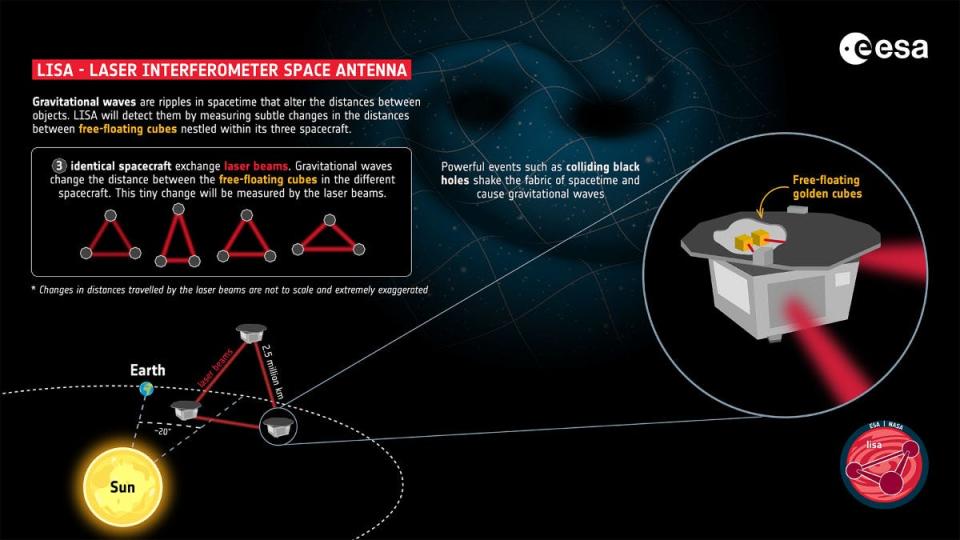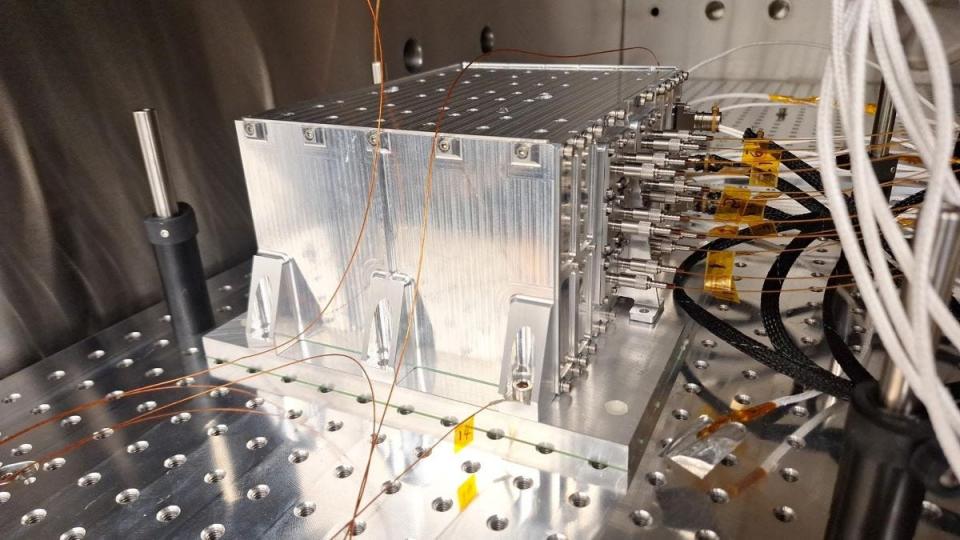Hardware developed by UF's College of Engineering will blast off to space with NASA
A piece of technology created by the University of Florida’s Herbert Wertheim College of Engineering will fly to space with the National Aeronautics and Space Administration (NASA).
The endeavor adopted by the European Space Agency (ESA), called the Laser Interferometer Space Antenna (LISA) mission, will serve as a gravitational wave observatory to detect waves low at frequencies, much lower than ground-based telescopes can. Students ranging from undergrads to postdocs, as well as faculty with UF’s Precision Space Systems Laboratory (PSSL) will develop Charge Management Devices (CMD) for the mission.
The CMDs are controlled by the spacecraft’s computers and emits ultraviolet (UV) light with precise timing and intensities. A news release said this UV light is channeled through multi-core optical fiber cables that are custom designed to release photoelectrons from LISA’s test masses, which are golden cubes freely floating inside the spacecraft without any physical contact. The cubes, which act as gravity sensors, also act as end mirrors for laser beams that are necessary to detect gravitational waves.

Keeping the gravity sensors at a neutral electric charge is essential to minimize forces that could disrupt the detection of gravitational waves. LISA must operate in an environment free of any outside forces – less than one-quadrillionth of Earth’s gravitational pull, a news release said. This level of sensitivity could be compared to detecting the minute weight of a single large virus or small bacterium, it said.
The CMDs will prevent electric charge build-up on test masses, therefore preventing the creation of noise which would disrupt the observation of gravitational waves.
The release also says the university is the only academic institution in the country to be awarded a contract to develop hardware that will fly on the LISA mission.
“ESA's adoption of LISA paves the way for a deeper understanding of our universe,” said Peter Wass, Ph.D., program manager at the PSSL, in a press release. “At the University of Florida, we're deeply proud of our role in this groundbreaking mission."
The mission will consist of three spacecraft orbiting the sun, each separated by 1.5 million miles, which relay laser beams back and forth between different spacecraft. These signals will then combine to search for gravitational wave signatures that are produced from distortions of space-time.
UF was awarded a 5-year, $12.5 million contract by NASA to develop the prototype. Simon Barke, assistant research scientist at the Department of Mechanical and Aerospace Engineering, said a follow up contract to move beyond prototypes to develop and build the actual CMD hardware for the 2035 launch would probably be more costly.
Initial stages: UF awarded NASA grant for space exploration technology
Barke came to UF over eight years ago as a postdoctoral researcher to work on a project unrelated to the mission. Before this, he worked for the LISA mission in his home country of Germany and, after a couple years at UF, switched departments from Physics to Mechanical and Aerospace Engineering, working again with the LISA mission, this time in the United States.
A UF news release in 2020 announced the cost-no-fee contract and its term, which runs from Jan. 1, 2021 through July 31, 2025. Under the contract, UF will “design, fabricate, integrate, test, verify and deliver” the breadboard (board for prototyping circuits), Fiber Optic Harness, Engineering Development Unit and Engineering Test Unit CMD.
About the device
Each CMD uses 12 UV light-emitting diodes (LEDs), a news release said, and six CMDs are needed across three spacecraft. These devices must be reliable and operate for the duration of the LISA mission – possibly five to 10 years in space – as well as meet strict standards for weight and power.

Another UF department is also contributing to the mission. The Department of Physics will develop telescopes that will beam the laser between the three LISA spacecraft. This team must ensure the telescope's dimensional stability against temperature fluctuations to a picometer (equal to one trillionth of a meter) scale, a news release said.
“That's the accuracy we are aiming for and only then we will be able to detect gravitational waves,” said Barke in an interview with The Sun. “Gravitational waves are all around us. They pass through earth, they pass through you and me all the time; but because they're so tiny, we don't notice it. If we would be able to measure them, then we can learn a lot about the astrophysical sources creating them… We can find out what source created them, where that source is, and then we can point our optical telescopes in this direction and take pictures of black holes or other massive objects out there.”
There are a lot of challenges to measuring distances that precisely, he said, one being that the spacecraft themselves are not positionally stable enough. To fix this, free-floating golden cubes called test masses are used, which are inside but unattached to the spacecraft.
This is where the CMD comes in: To keep the cubes from becoming positively or negatively charged by using a photoelectric effect to shine precise, controlled UV light onto the surfaces of the test masses. This will eject electrons from the test masses and bounce them back to the spacecraft. Similarly, the CMD can be used to take electrons from the spacecraft and deposit them on the test masses, then measure the charge again – without touching it – to make sure the test masses are always neutral.
The mission serves to “revolutionize researchers’ understanding of the universe, enhancing scientific knowledge beyond what can be obtained through electromagnetic waves,” a press release said. The technology developed to detect gravitational waves has other benefits, too: it can also help combat climate change by tracking mass change of continents and countries due to climate change and water shortages, Barke said.
LISA is set to launch in the mid-2030s and aims to advance the understanding of the universe, such as the origin and evolution of supermassive black holes, which Barke said cannot be observed directly by conventional telescopes.
“Since it's so heavy, it would be extremely loud in terms of gravitational waves,” he said. “So we could hear the hum of black holes colliding all over space… We can detect invisible objects, objects invisible to our other telescopes, and that's extremely fascinating.”
The hardware will be delivered to NASA, who will then deliver it to the European Space Agency (ESA) to be integrated into the spacecraft.
This article originally appeared on The Gainesville Sun: University of Florida College of Engineering creates hardware for NASA

